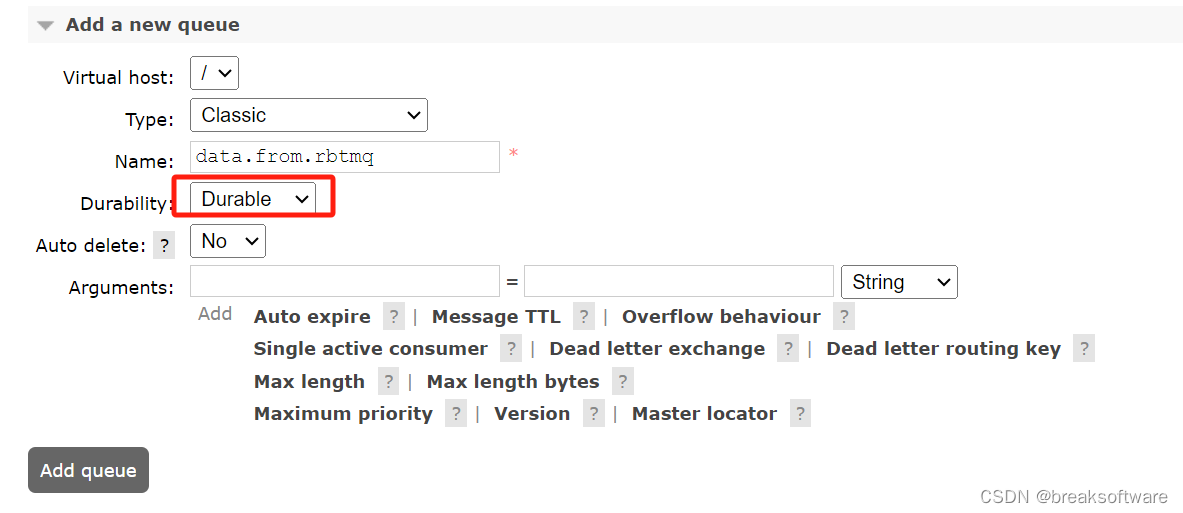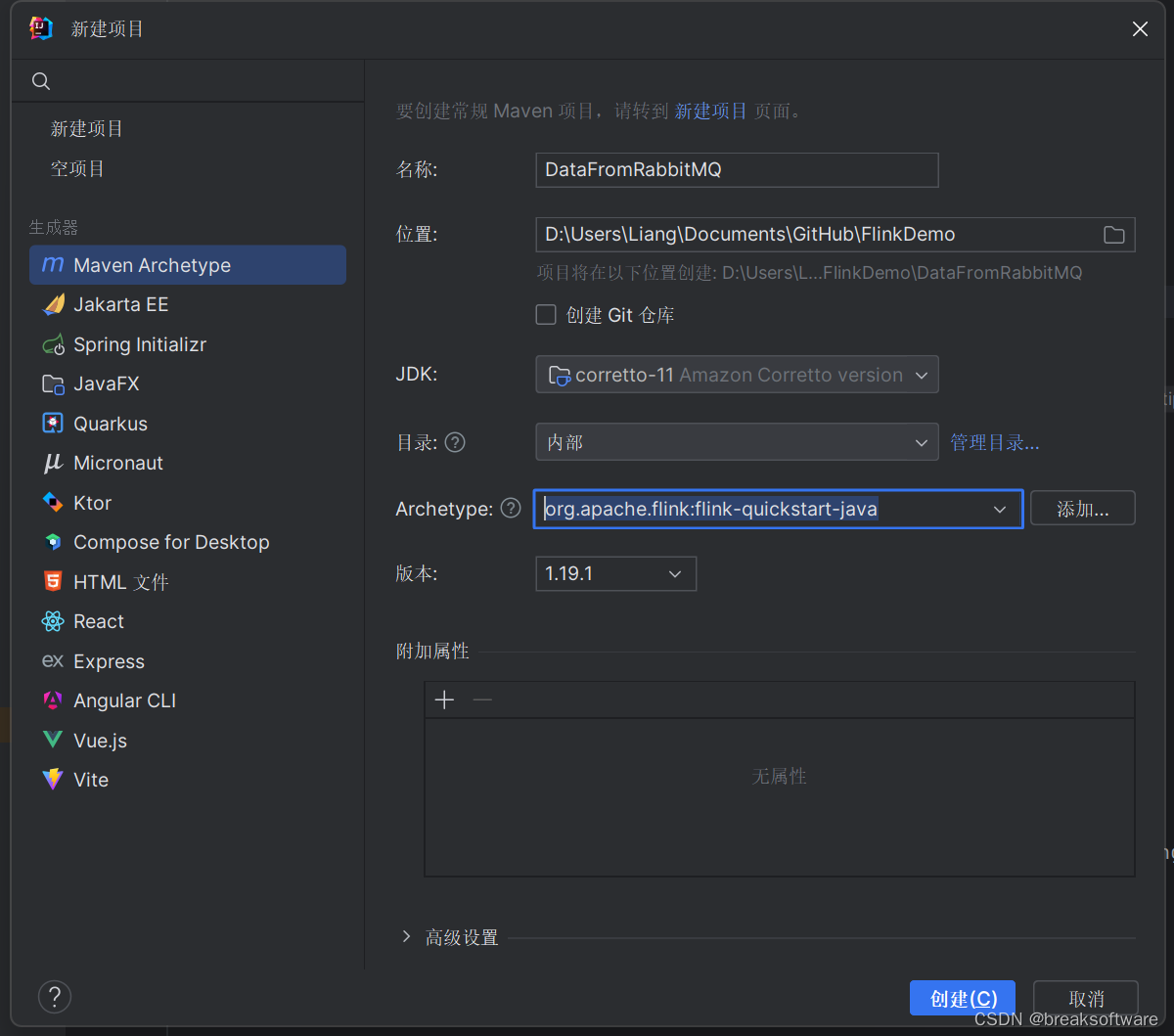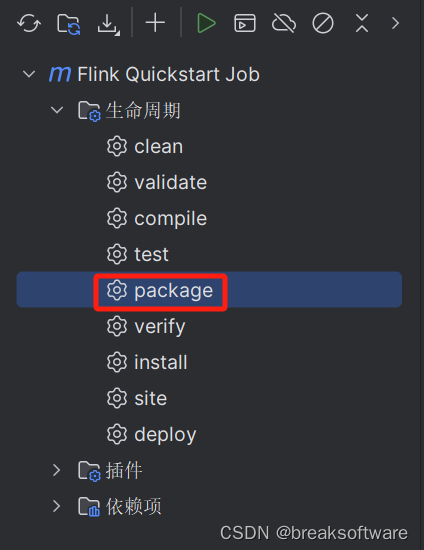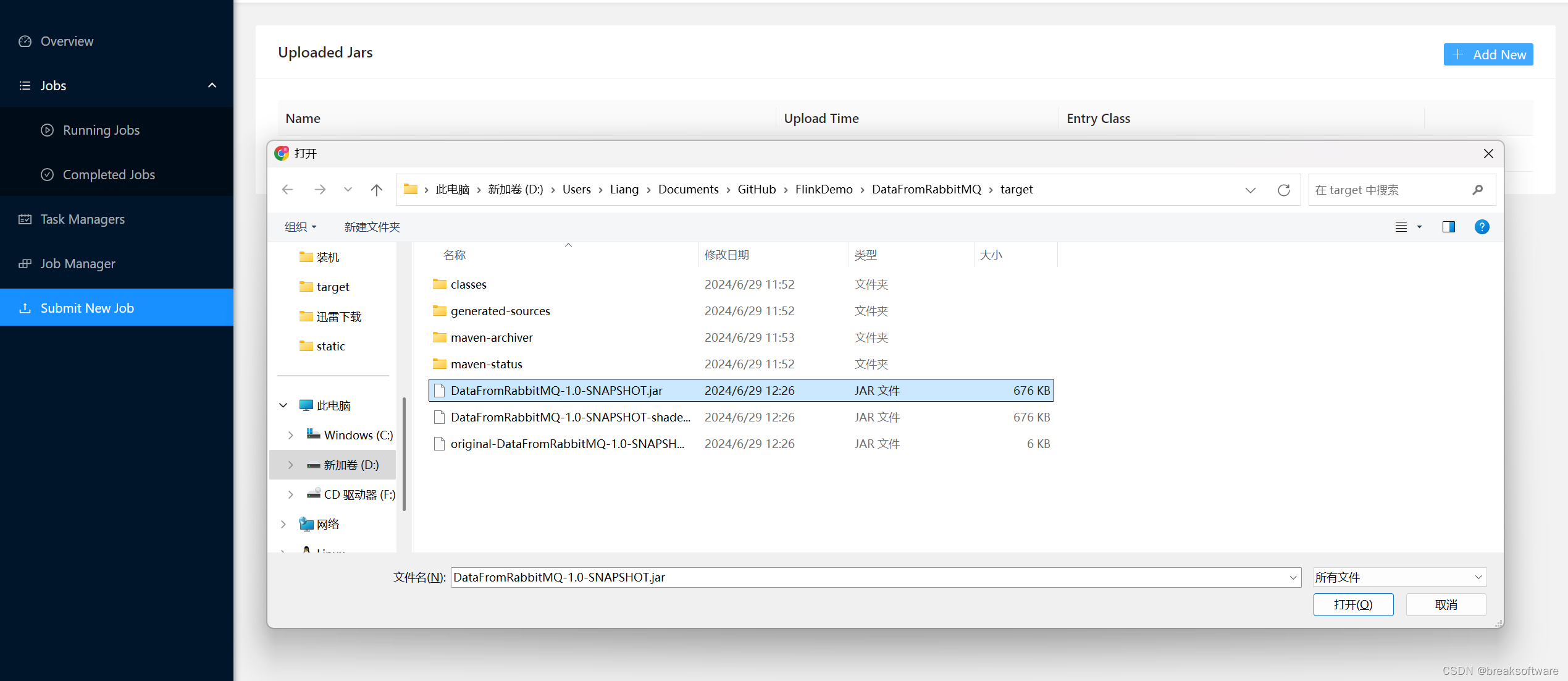Java版Flink使用指南——从RabbitMQ中队列中接入消息流
大纲
- 创建RabbitMQ队列
- 新建工程
- 新增依赖
- 编码
- 设置数据源配置
- 读取、处理数据
- 完整代码
- 打包、上传和运行任务
- 测试
- 工程代码
在《Java版Flink使用指南——安装Flink和使用IntelliJ制作任务包》一文中,我们完成了第一个小型Demo的编写。例子中的数据是代码预先指定的。而现实中,数据往往来源于外部。本文我们将尝试Flink从RabbitMQ中读取数据,然后输出到日志中。
关于RabbitMQ的知识可以参阅《RabbitMQ实践》。
创建RabbitMQ队列
我们创建一个Classic队列data.from.rbtmq。注意要选择Durable类型,这是后续用的默认连接器的限制。
具体方法见《RabbitMQ实践——在管理后台测试消息收发功能》。
后续我们将在后台通过默认交换器,给这个队列新增消息。
新建工程
我们在IntelliJ中新建一个工程DataFromRabbitMQ。
Archetype填入:org.apache.flink:flink-quickstart-java。
版本填入与Flink的版本:1.19.1
新增依赖
在pom.xml中新增RabbitMQ连接器
org.apache.flink flink-connector-rabbitmq 3.0.1-1.17
编码
设置数据源配置
String queueName = "data.from.rbtmq"; String host = "172.21.112.140"; // IP of the rabbitmq server int port = 5672; String username = "admin"; String password = "fangliang"; String virtualHost = "/"; int parallelism = 1; // create a RabbitMQ source RMQConnectionConfig rmqConnectionConfig = new RMQConnectionConfig.Builder() .setHost(host) .setPort(port) .setUserName(username) .setPassword(password) .setVirtualHost(virtualHost) .build(); RMQSource rmqSource = new RMQSource(rmqConnectionConfig, queueName, true, new SimpleStringSchema());
读取、处理数据
下面代码通过addSource添加RabbitMQ数据源。注意,不能使用fromSource方法,是因为RMQSource没有实现SourceFunction方法。
final DataStream stream = env.addSource(rmqSource).name(username + "'s source from " + queueName).setParallelism(parallelism); stream.print().name(username + "'s data from " + queueName);
完整代码
/* * Licensed to the Apache Software Foundation (ASF) under one * or more contributor license agreements. See the NOTICE file * distributed with this work for additional information * regarding copyright ownership. The ASF licenses this file * to you under the Apache License, Version 2.0 (the * "License"); you may not use this file except in compliance * with the License. You may obtain a copy of the License at * * http://www.apache.org/licenses/LICENSE-2.0 * * Unless required by applicable law or agreed to in writing, software * distributed under the License is distributed on an "AS IS" BASIS, * WITHOUT WARRANTIES OR CONDITIONS OF ANY KIND, either express or implied. * See the License for the specific language governing permissions and * limitations under the License. */ package org.example; import org.apache.flink.api.common.serialization.SimpleStringSchema; import org.apache.flink.streaming.api.datastream.DataStream; import org.apache.flink.streaming.api.environment.StreamExecutionEnvironment; import org.apache.flink.streaming.connectors.rabbitmq.RMQSource; import org.apache.flink.streaming.connectors.rabbitmq.common.RMQConnectionConfig; /** * Skeleton for a Flink DataStream Job. * *
For a tutorial how to write a Flink application, check the * tutorials and examples on the Flink Website. * *
To package your application into a JAR file for execution, run * 'mvn clean package' on the command line. * *
If you change the name of the main class (with the public static void main(String[] args)) * method, change the respective entry in the POM.xml file (simply search for 'mainClass'). */ public class DataStreamJob { public static void main(String[] args) throws Exception { // Sets up the execution environment, which is the main entry point // to building Flink applications. final StreamExecutionEnvironment env = StreamExecutionEnvironment.getExecutionEnvironment(); String queueName = "data.from.rbtmq"; String host = "172.21.112.140"; // IP of the rabbitmq server int port = 5672; String username = "admin"; String password = "fangliang"; String virtualHost = "/"; int parallelism = 1; // create a RabbitMQ source RMQConnectionConfig rmqConnectionConfig = new RMQConnectionConfig.Builder() .setHost(host) .setPort(port) .setUserName(username) .setPassword(password) .setVirtualHost(virtualHost) .build(); RMQSource rmqSource = new RMQSource(rmqConnectionConfig, queueName, true, new SimpleStringSchema()); final DataStream stream = env.addSource(rmqSource).name(username + "'s source from " + queueName).setParallelism(parallelism); stream.print().name(username + "'s data from " + queueName); env.execute("Flink Java API Skeleton"); } }
打包、上传和运行任务
测试
在RabbitMQ后台的默认交换器中,发布一条消息到data.from.rbtmq
然后使用下面指令可以看到Flink读取到消息并执行了print方法
tail log/flink-*-taskexecutor-*.out
==> flink-fangliang-taskexecutor-0-fangliang.out











